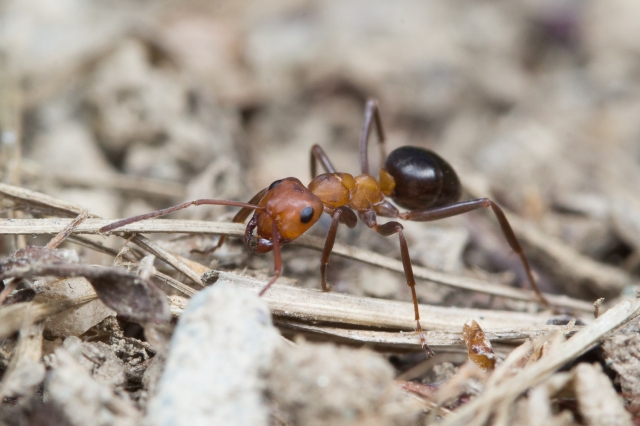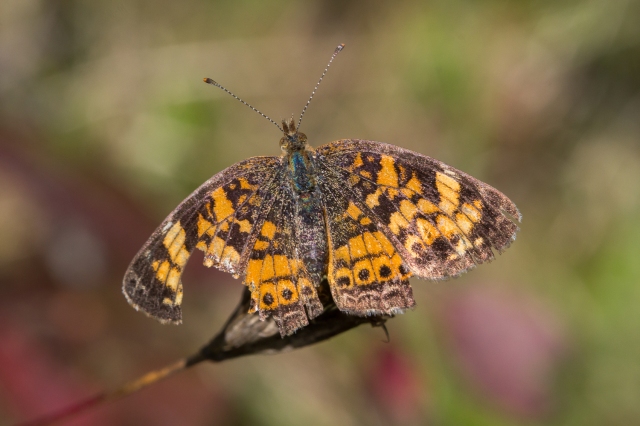By Kyle Bradford
For this Wonder Wander, I took a walk in the pastures north of Hawthorne Valley’s main farm. My first stop was at the base of the North Hill pastures in a wet meadow where I found some Alleghany Monkey-flowers (Mimulus ringens) with their seed pods. This is a wetland plant whose flowers are commonly visited by bumblebees.
Moving up into the dry pastures I was curious what the insects, especially the ants, were up to in the warm fall weather. Despite being in the second official week of autumn, the temperatures were reaching the 70’s and 80’s. Ants are ectotherms meaning they cannot produce their own heat, instead, they rely on the environment for warmth. Ant distributions, diversity, and behavior are highly sensitive to temperature. In our region ants are usually active when temperatures exceed 60 degrees Fahrenheit. The warm, dry pastures at Hawthorne Valley, although not super productive agriculturally, are quite productive for ant diversity, including some rare and interesting species.
I made a stop to revisit a nest of the Alleghany Mound Ant (Formica exsectoides) I found last week. This ant makes the largest mounds we see in our region, up to three feet in height! Their colonies can last for decades. If you see a large ant mound with bicolored red and black ants, you’re most likely looking at the Alleghany Mound Ant.
In the field, if you pick a worker up and look at it with a hand lens you’ll see its concave head, which is diagnostic for this species in our region.
A second interesting Formica on North Hill is Formica prociliata, which before we found it in Columbia County was previously unknown from New York or anywhere else in the Northeast.
The species was first described from Ohio, which was thought to be its eastern range limit, where it nests in glaciated prairie remnants. It’s also been reported from Michigan, Missouri, Wisconsin and Iowa. In Columbia County, we’ve recorded it at over a dozen sites usually nesting in dry fields often associated with the native grass Little Bluestem (Schizachyrium scoparium).

Formica prociliata nest site on North Hill. The nest is under the two clumps of Little Bluestem where there is bare soil.
Many questions remain about this particular ant species. Is it in fact disjunct from the midwestern populations? If it’s disjunct, how long has it been isolated? At this time, I can only offer untested thoughts. I can imagine the possibility of this ant being more widespread in the northeast post-glaciation 12,000 or so years ago. At that time organisms from the edge of the glaciers would have been recolonizing the barren rock, sand, and stone rubble that was left after the glaciers receded and grasslands would’ve been more widespread before forests started dominating the region. Perhaps our local, thin-soil hillsides were conducive to being kept open from natural and human disturbances, such as fire, preserving the ant’s prairie-like habitat through time. We may never know for sure what the landscape looked like and what organisms were here thousands of years ago, but in any case, this species is a unique part of our current local biodiversity. It’s one example of how light agricultural management can provide habitat for regionally uncommon species. Without the human hand keeping some dry fields open, this ant would surely disappear from the County.
Moving to the field and forest edge at the top of the hill I found a nest of Crematogaster lineolata under a rock. The genus Crematogaster has some interesting morphology. Their heart-shaped abdomens (gaster) are connected upside down! Most ants have the ends of their abdomens pointed down, some with stingers others with openings that spray defensive liquids like formic acid. The Crematogaster are able to put their gaster over their thorax and head and using a spatula-shaped stinger they secrete a noxious liquid. The liquid may be directly applied to prey or invaders or can be dropped on their hairy thoraxes helping to repel enemies. When the ants put their abdomen over their head, they look like they’re performing a balancing act, which gives them the common name Acrobat Ants.
When not looking at the ground for ants I would see an occasional butterfly, usually Pearl Crescents (Phyciodes tharos). Sometimes they would nectar on the asters or simply stop for a rest on the vegetation. This individual didn’t look too worn but did have a sizable bite taken out of its wing.
In the shrubbier sections of North Hill, I stopped to admire some Red Cedars (Juniperus virginiana), this one had a nice crop of berries. Red Cedars provide important food and shelter for wildlife. A regionally rare butterfly, Juniper Hairstreak (Callophrys gryneus), caterpillars feed on the foliage. Berries are consumed by mammals and birds, like the Cedar Waxwing (Bombycilla cedrorum). The evergreen foliage and dense branch structure offer nesting and roosting sites for birds and offer valuable winter shelter.
I’ll leave you with the last photo I took on my walk. A view from the top of North Hill under the late afternoon light.












